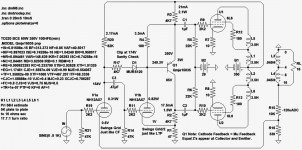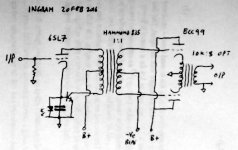With high-mu triodes you probably won't get more than a couple of volts on the drain.
The typical PI tube only has 1 to 4 volts of bias at the current used for a PI. Of course more voltage will be available with bigger tubes, or lower Mu triodes.
I never played with that type of circuit before, or the 10M45S.
My experiments with the 10M45 show that it needs about 10 volts to work right, but really wants 25 or more. I put a variable power supply on the negative rail and turned the knob. There was an obvious sound quality degradation below 5 volts across the 10M45, and distortion numbers continued to drop as the voltage increased. It leveled off at 10 volts and quit changing at 20, so I always use at least 25 volts, usually a lot more since the output tubes bias comes from the same rail.
For a small amp with B+ under 400 volts, take two silicon diodes and a small electrolytic cap off the power transformer to create a negative supply equal to the positive B+. Feed one 10M45 with that negative voltage to operate the LTP, and another 10M45 to create a negative current (5 mA or so). Apply that current to a 10K or so pot to generate the negative bias for the output tubes.....easy, no taps on the power transformer needed. Heat sink the 10M45's to the chassis.
Member
Joined 2009
Paid Member
It is a good approach if you want 22K grid leak resistors, but if you have them 220K, why bother with an extra transistor and it's distortions? However, such a way you can squeeze a bit more from output tubes before saturation... But anyway you have coupling caps, so I would not recommend to do so.
Member
Joined 2009
Paid Member
OK, how about this, a bit of 'crazy'. The ARC uses cathode feedback, but this needs a fancy OPT for good results. So why not put the OPT into the cathode, the output stage is then a follower with no gain but good damping factor. Tubelab has tried something along these lines and liked it. It needs high voltage drive which favours a choke loaded driver for maximum swing. I have a pair of unused IT's, Hammond 835s which don't allow any unbalanced d.c. but they would make nice phase splitters. So the driver would be a single high-mu triode with a bypassed current mirror in the cathode to balance the current through the primary of the IT. I'd envisage a B+ of around 280V. It might be worth cascading the BJT but there are a number of 350V+ Vce parts available. I could make the driver an LTP, but I'd rather use the symmetry of the IT to do the phase-splitting instead of the potentially mismatched triodes in an LTP. The current mirror needs a bit of finessing yet, it's not balanced as drawn and there will be some worries over power-up sequencing to clarify too.
Thoughts ?
Thoughts ?
Attachments
Last edited:
You can put your OPT in cathode, but a first, don't expect full possible swing, and second, you shift the problem into the driver that needs to deliver the same voltage swing. McIntosh went a half way, splitting equally windings between anode and cathode, and had to overcome heroically driver problems.
To make a cathode feedback just use 4 Ohm and 16 Ohm taps, ground 4 Ohm one, and use 0 and 16 Ohm taps for feedback.
But do you really need to repeat that AR schematics? Can't you come with something better than a tube simulation of a solid state amp?
To make a cathode feedback just use 4 Ohm and 16 Ohm taps, ground 4 Ohm one, and use 0 and 16 Ohm taps for feedback.
But do you really need to repeat that AR schematics? Can't you come with something better than a tube simulation of a solid state amp?
Member
Joined 2009
Paid Member
I won't build the ARC design, too many parts I don't have and unecessary complexity, but I like to get in the head of the designer a bit. Now, the follower output option is quite different and possibly elegant if the driver can do its job. The IT is a nice way to get the split phase (remember Amnity?) and I have a pair of these trafo's sitting idle. There is a limit to the swing though, one being the driver gain (mu at best) and the other being the heater-cathode max voltage rating of the output tube (datasheet for JJ ECC99 is 200V, but Russian 6H6P is 100V).
Could I do better? Depends what better is, there are system constraints given this is a desktop amp but I see many alternative topologies each with different tradeoffs. And I have some SS amps that I like so why not cross pollinate! I am still looking...
Could I do better? Depends what better is, there are system constraints given this is a desktop amp but I see many alternative topologies each with different tradeoffs. And I have some SS amps that I like so why not cross pollinate! I am still looking...
Last edited:
There is a guy on e-pay Canada selling Japanese Tomiko OPT's. I had pretty good results with single ended ones, so maybe the PP's are good too. I got mine in Japan pretty cheap... I got the cheapest ones possible and for their small size and price they perform well. I use them mostly for testing. I think they all have UL tap, so you can have some good fun with small pentodes, etc..
The only thing with these little cheap OPT's is that they will distort more and the frequency response will be audibly worse. Going even smaller will be worse.
Maybe it would help to know how small (in dimensions) you want to go with this..
The only thing with these little cheap OPT's is that they will distort more and the frequency response will be audibly worse. Going even smaller will be worse.
Maybe it would help to know how small (in dimensions) you want to go with this..
Member
Joined 2009
Paid Member
I found this. 1 Tomiko 8K Push Pull 10W Output Transformer 6AQ5 ELL80 6GH8 DL95 EL95 6BM8 EL84 | eBay
With shipping it's Cdn$120(?) yet the casing looks cheap and nasty. Whether you believe they sound good enough, there are Edcor OPT's at more attractive prices.
This is a desktop amp, so I figure it should have a footprint of around the size of A5 / half letter (8" x 6") or a regular iPad. Maybe this is expecting too much.
With shipping it's Cdn$120(?) yet the casing looks cheap and nasty. Whether you believe they sound good enough, there are Edcor OPT's at more attractive prices.
This is a desktop amp, so I figure it should have a footprint of around the size of A5 / half letter (8" x 6") or a regular iPad. Maybe this is expecting too much.
Last edited:
Member
Joined 2009
Paid Member
Looks like those ECC99 output tubes could be readily replaced by the IXTP08N100D2 depletion mode FET. Solves the heater-cathode voltage rating issue.
Member
Joined 2009
Paid Member
Yes its kind of ugly, but maybe some covers from another transformer will fit.
70V 10W Speaker Line Matching Transformer
hook the tube plates to the purple and black wires, B+ on brown. Speaker connected as normal. Be careful there are two black wires. Check continuity with an ohmmeter first. I can get 5 watts through these with good results down to about 50 Hz on 170 volts of B+ (rectified output of an isolation transformer).
What's the turns-ration on these, trying to future out what primary impedance would be reflected from an 8 Ohm load ?
For those line matching transformer, the primary impedance is given by line voltage squared divided by the wattage tap. 70v line transformer on 0.625W should give 8K to 8R. For pushpull duty, center tap is on the 2.5W tap (2K).
Looks like those ECC99 output tubes could be readily replaced by the IXTP08N100D2 depletion mode FET. Solves the heater-cathode voltage rating issue.
Exactly. Use source follower outputs, and bootstrap from sources anode load resistors.
The problem is solved.
I found this. 1 Tomiko 8K Push Pull 10W Output Transformer 6AQ5 ELL80 6GH8 DL95 EL95 6BM8 EL84 | eBay
With shipping it's Cdn$120(?) yet the casing looks cheap and nasty. Whether you believe they sound good enough, there are Edcor OPT's at more attractive prices.
This is a desktop amp, so I figure it should have a footprint of around the size of A5 / half letter (8" x 6") or a regular iPad. Maybe this is expecting too much.
Wow, that's small. These would be too big for that anyway.
Too bad his shipping quote is insane. Edocor would indeed be cheaper. I got mine cheap in tiny hole-in-the-wall shop in Tokyo Akihabara a few years back.
The ones I have looked cheap-and-nasty too so I used spray-paint. Mine are 6x6x5 cm. Work well with cheap Chinese tubes in my office. The footprint is however A4. Its nice to have a *bit* of space in the chassis to work with...
Member
Joined 2009
Paid Member
For those line matching transformer, the primary impedance is given by line voltage squared divided by the wattage tap. 70v line transformer on 0.625W should give 8K to 8R. For pushpull duty, center tap is on the 2.5W tap (2K).
Thanks !
So, if desired, I could operate with MOSFET source follower output and use a higher power tap with lower turns ratio. I can use a lower B+ and the FETs can be matched in advance, they won't drift later with age. It's tarting to morph into the Moth Audio Seth turned into a Susan Parker Zeus amp ....

- Status
- Not open for further replies.
- Home
- Amplifiers
- Tubes / Valves
- small shrouded PP OPT choices ?

